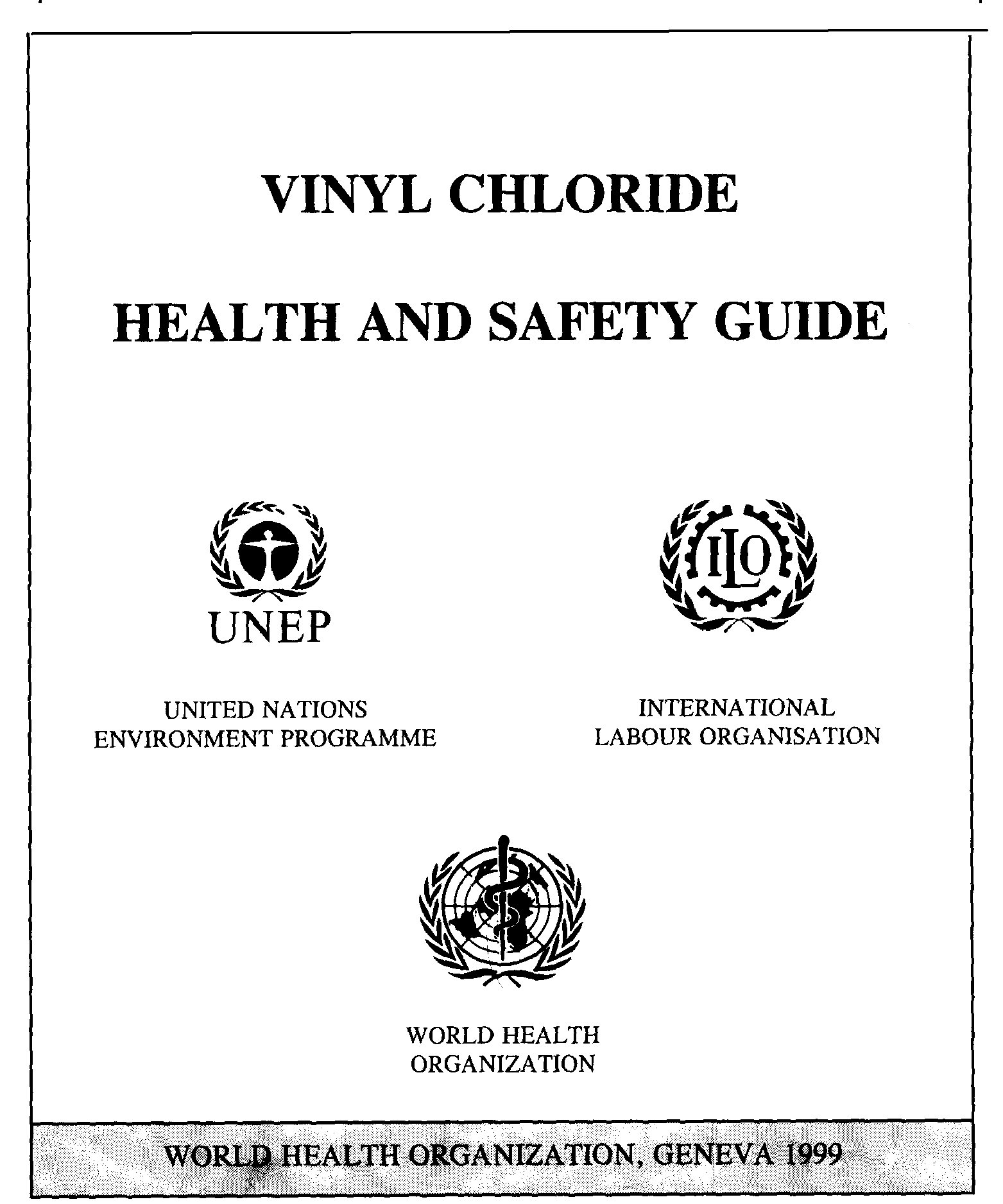
Health and Safety Guide No. 109
This is a companion volume to Environmental Health Criteria 215: Vinyl chloride
Published by the World Health Organization for the International Programme on Chemical Safety (a collaborative programme of the United Nations Environment Programme, the International Labour Organisation, and the World Health Organization) and produced within the framework of the Inter-Organization Programme for the Sound Management of Chemicals
This report contains the collective views of an international group of experts and does not necessarily represent the decisions or the stated policy of the United Nations Enviromment Programme, the International Labour Organisation, or the World Health Organization.
WHO Library Cataloguing in Publication Data
Vinyl chloride: health and safety guide.
(Health and safety guide; no. 109)
l.Vinyl chloride - toxicity 2.Enviromnental exposure 3.Occupational exposure 4.Guidelines
I. International Programme on Chemical Safety. II.Series
ISBN 92 4151109 5
(NLM Classification: QV 633)
ISSN 0259-7268
The World Health Organization welcomes requests for permission to reproduce or translate its publications, in part or in full. Applications and enquiries should be addressed to the Office of Publications, World Health Organization, Geneva, Switzerland, which will be glad to provide the latest information on any changes made to the text, plans for new editions, and reprints and translations already available.
Publications of the World Health Organization enjoy copyright protection in accordance with the provisions of Protocol 2 of the Universal Copyright Convention. All rights reserved.
The designations employed and the presentation of the material in this publication do not imply the expression of any opinion whatsoever on the part of the Secretariat of the World Health Organization concerning the legal status of any country, territory, city or area or of its authorities, or concerning the delimitation of its frontiers or boundaries.
The mention of specific companies or of certain manufacturers’ products does not imply that they are endorsed or recommended by the World Health Organization in preference to others of a similar nature that are not mentioned. Errors and omissions excepted, the names of proprietary products are distinguished by initial capital letters.
The Federal Ministry for the Environment, Nature Conservation
and Nuclear Safety (Germany) provided
financial support for, and undertook the printing of, this publication
Printed by Wissenschaftliche Verlagsgesellschaft mbH. D-70009 Stuttgart 10
Pages INTRODUCTION 5 1 PRODUCT IDENTITY AND USES 7 1.1 Identity 7 1.2 Physical and chemical properties 7 1.3 Conversion factors 7 1.4 Analytical methods 8 1.5 Production and uses 8 2 SUMMARY AND EVALUATION 9 2.1 Exposure 9 2.1.1 General population 9 2.1.2 Occupational exposure 10 2.2 Uptake, metabolism and exoretion 10 2.3 Effects on organisms in the environment 11 2.4 Effects on experimental animals and in vitro test systems 12 2.5 Effects on humans 14 3 RECOMMENDATIONS FOR PROTECTION OF HUMAN HEALTH 16 3.1 Public health 16 3.2 Occupational health 16 4 HUMAN HEALTH HAZARDS, PREVENTION AND PROTECTION, EMERGENCY ACTION 17 4.1 Human health hazards, prevention and protection, first aid 17 4.1.1 Information for physicians 17 4.1.1.1 Signs and symptoms of exposure 17 4.1.1.2 First aid 17 4.1.1.3 Medical treatment 17 4.1.1.4 Effects of chronic exposure 18 4.1.2 Health surveillance advice 18 4.1.2.1 Initial medical screening 18 4.1.2.2 Periodic medical examination 18 4.1.3 Prevention and protection 18 4.2 Explosion and fire hazards 19 4.2.1 Explosion hazards 19 4.2.2 Fire hazards 19 4.3 Handling and storage 19 4.4 Spillage 20 5 HAZARDS FOR THE ENVIROMMENT AND THEIR PREVENTION 21 6 SUMMARY OF CHEMICAL SAFETY INFORMATION 22 7 CURRENT REGULATIONS, GUIDELINES AND STANDARDS 25 7.1 Previous evaluations by international bodies 25 7.2 Occupational exposure limit values 25 7.3 Labelling, packaging and transport 25 7.4 Waste disposal 25 BIBLIOGRAPHY 27
The Environmental Health Criteria (EHC) monographs produced by the International Programme on Chemical Safety include an assessment of the effects on the enviromnent and on human health of exposure to a chemical or combination of chemicals, or physical or biological agents. They also provide guidelines for setting exposure limits.
The purpose of a Health and Safety Guide is to facilitate the application of these guidelines in national chemical safety prograrnmes. The first three sections of a Health and Safety Guide highlight the relevant technical information in the corresponding EHC. Section 4 includes advice on preventive and protective measures and emergency action; health workers should be thoroughly familiar with the medical information to ensure that they can act efficiently in an emergency. Within the Guide is a Summary of Chemical Safety Information which should be readily available, and should be clearly explained, to all who could come into contact with the chemical. The section on regulatory information has been extracted from the legal file of the International Register of Potentially Toxic Chemicals (IRPTC) and from other United Nations sources.
The target readership includes occupational health services, those in ministries, governmental agencies, industry, and trade unions who are involved in the safe use of chemicals and the avoidance of environmental health hazards, and those wanting more information on this topic. An attempt has been made to use only terms that will be familiar to the intended user. However, sections 1 and 2 inevitably contain some technical terms. A bibliography has been included for readers who require further background information.
Revision of the information in this Guide will take place in due course, and the eventual aim is to use standardized terminology. Comments on any difficulties encountered in using the Guide would be very helpful and should be addressed